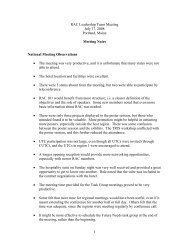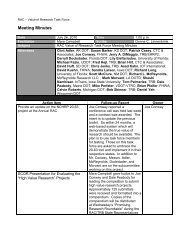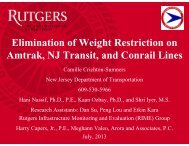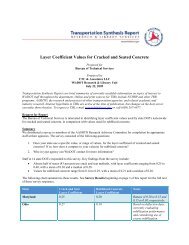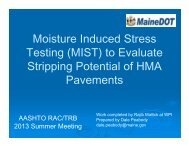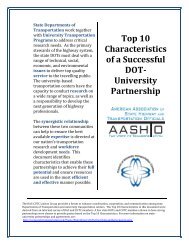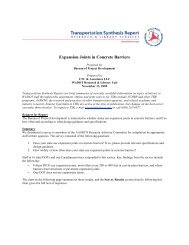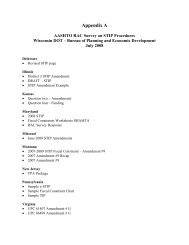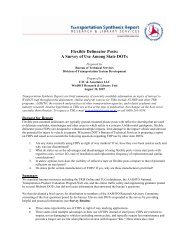Joint Maintenance and Repair on Doweled, Jointed Plain Concrete ...
Joint Maintenance and Repair on Doweled, Jointed Plain Concrete ...
Joint Maintenance and Repair on Doweled, Jointed Plain Concrete ...
Create successful ePaper yourself
Turn your PDF publications into a flip-book with our unique Google optimized e-Paper software.
Transportati<strong>on</strong>Synthesis ReportResearch <str<strong>on</strong>g>and</str<strong>on</strong>g> Communicati<strong>on</strong> ServicesWisc<strong>on</strong>sin Department of Transportati<strong>on</strong>608-261-8198wisdotresearch@dot.state.wi.usRequest a TSR: pat.casey@ctc<str<strong>on</strong>g>and</str<strong>on</strong>g>associates.com<str<strong>on</strong>g>Joint</str<strong>on</strong>g> <str<strong>on</strong>g>Maintenance</str<strong>on</strong>g> <str<strong>on</strong>g>and</str<strong>on</strong>g> <str<strong>on</strong>g>Repair</str<strong>on</strong>g>On <strong>Doweled</strong>, <str<strong>on</strong>g>Joint</str<strong>on</strong>g>ed <strong>Plain</strong> C<strong>on</strong>crete PavementPrepared forBureau of Technical ServicesPrepared byCTC & Associates LLCWisDOT Research & Communicati<strong>on</strong> ServicesDecember 22, 2006Transportati<strong>on</strong> Synthesis Reports are brief summaries of currently available informati<strong>on</strong> <strong>on</strong> topics of interest toWisDOT technical staff. Online <str<strong>on</strong>g>and</str<strong>on</strong>g> print sources for TSRs include NCHRP <str<strong>on</strong>g>and</str<strong>on</strong>g> other TRB programs, AASHTO, theresearch <str<strong>on</strong>g>and</str<strong>on</strong>g> practices of other transportati<strong>on</strong> agencies, <str<strong>on</strong>g>and</str<strong>on</strong>g> related academic <str<strong>on</strong>g>and</str<strong>on</strong>g> industry research. Internethyperlinks in TSRs are active at the time of publicati<strong>on</strong>, but changes <strong>on</strong> the host server can make them obsolete.Request for ReportThe Bureau of Technical Services requested informati<strong>on</strong> <strong>on</strong> other state DOTs’ practices for repairing joints ofjointed plain c<strong>on</strong>crete pavement with dowels. Of particular interest was the percentage of joints typically treatedduring the first significant repair effort, whether grinding of joints is always part of the process, <str<strong>on</strong>g>and</str<strong>on</strong>g> how l<strong>on</strong>g therepair is expected to last.SummaryIn additi<strong>on</strong> to a search of transportati<strong>on</strong> databases, we surveyed AASHTO Research Advisory Committeerepresentatives <str<strong>on</strong>g>and</str<strong>on</strong>g> received 20 resp<strong>on</strong>ses, including Wisc<strong>on</strong>sin’s. Our Web search found FHWA directi<strong>on</strong> <strong>on</strong> jointspacing <str<strong>on</strong>g>and</str<strong>on</strong>g> grinding practices, emphasizing a maximum joint space of 15 feet <str<strong>on</strong>g>and</str<strong>on</strong>g> the use of diam<strong>on</strong>d grinding inall but severe material-related joint distress c<strong>on</strong>diti<strong>on</strong>. A Michigan directive bases its use of milling <strong>on</strong> spall sizesless than two feet, with larger damage requiring full rehabilitati<strong>on</strong>. Aside from this Michigan directive <str<strong>on</strong>g>and</str<strong>on</strong>g> generalFHWA guidance, the state of the practice in joint maintenance <str<strong>on</strong>g>and</str<strong>on</strong>g> repair does not appear to enjoy generaldisseminati<strong>on</strong> <strong>on</strong> the Web.The RAC survey filled that gap. The table of research resp<strong>on</strong>ses <strong>on</strong> the next page shows that the 15-foot jointspacing limit is widely embraced, that the first major repair of c<strong>on</strong>crete pavement joints generally falls in the rangeof 20 to 25 years, <str<strong>on</strong>g>and</str<strong>on</strong>g> that grinding is not always d<strong>on</strong>e, though closer inspecti<strong>on</strong> of survey resp<strong>on</strong>ses shows it is d<strong>on</strong>ein the majority of repair situati<strong>on</strong>s. The amount of joints repaired in a stretch of highway varies dramatically am<strong>on</strong>gthe resp<strong>on</strong>dents, from <strong>on</strong>e percent to 20 percent. The expectati<strong>on</strong> of service life after the first major repair also variesfairly widely; a c<strong>on</strong>servative, 10-year expectati<strong>on</strong> is comm<strong>on</strong>, but ambitious expectati<strong>on</strong>s range up to 45 years.We begin our report with a Survey Snapshot of resp<strong>on</strong>ses from the RAC survey, followed by the detailed SurveyResp<strong>on</strong>ses, <str<strong>on</strong>g>and</str<strong>on</strong>g> then look at a few guidelines for joint repair, State of the Practice.Survey SnapshotWe sent the following questi<strong>on</strong>s to RAC members:1. What is the distance between pavement joints in your state? In Wisc<strong>on</strong>sin, it's every 15 to 18 feet.2. When does LCCA indicate the first major joint repair will be required? In Wisc<strong>on</strong>sin, it's at 25 years.3. When you perform joint repair, how many joints, in number per mile or percentage per mile, do you typically do?4. Is grinding always a part of this first repair?5. How l<strong>on</strong>g do you expect this first rehab to last before requiring a sec<strong>on</strong>d?
AASHTO RAC Survey<str<strong>on</strong>g>Joint</str<strong>on</strong>g> <str<strong>on</strong>g>Repair</str<strong>on</strong>g> Practices for <str<strong>on</strong>g>Joint</str<strong>on</strong>g>ed <strong>Plain</strong> C<strong>on</strong>crete PavementState<str<strong>on</strong>g>Joint</str<strong>on</strong>g> Spacing(feet)1st Major<str<strong>on</strong>g>Repair</str<strong>on</strong>g>(years)<str<strong>on</strong>g>Joint</str<strong>on</strong>g>s <str<strong>on</strong>g>Repair</str<strong>on</strong>g>ed(%) Always Grind?Next Major<str<strong>on</strong>g>Repair</str<strong>on</strong>g>(years)Arkansas 15 25 -- No 10Ariz<strong>on</strong>a 13 - 15 - 17 20 -- No 10 to 14Delaware 20 25 20 No 25Georgia 15 25 5 No 25Iowa 20 30 to 35 5 No 10 to 15Illinois 15 20 4 No 20Kansas 15 20 12 No 10Louisiana 20 20 1 No --Missouri 15 25 1.5 (of slab) Yes 45New Jersey 15 to 18 10 5 to 20 Yes <strong>on</strong> 2nd rehab 10New York 16 25 10 No 15-OctOhio 15 22 4 No 10Ontario, Can. 14 28 -- Yes 10Oreg<strong>on</strong> -- -- -- -- --Rhode Isl<str<strong>on</strong>g>and</str<strong>on</strong>g> -- -- -- -- --Virginia 15 20 -- Yes 10+Verm<strong>on</strong>t -- -- -- -- --Washingt<strong>on</strong> 15 20 to 30 -- Yes 10 to 25West Virginia 15 20 -- No 12Wisc<strong>on</strong>sin 15 to 18 25 -- -- --Survey Resp<strong>on</strong>sesArkansasDistance between joints – 15 feet.When first major repair – 25 years.<str<strong>on</strong>g>Joint</str<strong>on</strong>g>s repaired per mile during typical service – Not known; pavements less than 20 years old at this time.Grinding always? Probably, if noticeably faulted.Service life of first rehabilitati<strong>on</strong> – 10 years.C<strong>on</strong>tact. David A. Lambert, David.Lambert@arkansashighways.com.Ariz<strong>on</strong>aDistance between joints – Staggered at 13, 15, <str<strong>on</strong>g>and</str<strong>on</strong>g> 17 feet.When first major repair – 20 years.<str<strong>on</strong>g>Joint</str<strong>on</strong>g>s repaired per mile during typical service – Not known. Ariz<strong>on</strong>a had not rehabilitated enough doweled PCCpavements yet to know.Grinding always? – No. Grooving may be d<strong>on</strong>e, or asphalt rubber or asphaltic c<strong>on</strong>crete fricti<strong>on</strong> course overlaysmay be applied.Service life of first rehabilitati<strong>on</strong> – 10 to 14 years.C<strong>on</strong>tact. Paul Burch, State Pavement Design Engineer, 602.712.8085, pburch@azdot.gov.2
DelawareDelaware uses no formal LCCA value for scheduling, but typically some repairs are made before 5 years to correctc<strong>on</strong>structi<strong>on</strong>. C<strong>on</strong>crete pavements built before 1970 were rehabilitated with little joint repair by overlaying withHMA. Pavements in the late 1970s experienced rapid ASR deteriorati<strong>on</strong>, further skewing c<strong>on</strong>venti<strong>on</strong>al repairpractice.Distance between joints – 20 feet, since 1975 (45 feet from 1960 through 1974, <str<strong>on</strong>g>and</str<strong>on</strong>g> 65 feet before 1960).When first major repair – 25 years is expected.<str<strong>on</strong>g>Joint</str<strong>on</strong>g>s repaired per mile during typical service – Typically about 20 percent. Some projects require a much higherpercentage, in part because the number of joints requiring attenti<strong>on</strong> increases from the time of inspecti<strong>on</strong> to the timeof repair.Grinding always? For ride deficiency, not for joint repair, unless joint patching will be insufficient to maintain ridequality.Service life of first rehabilitati<strong>on</strong> – Under normal c<strong>on</strong>diti<strong>on</strong>s, 25 years or more is expected. The nature of thedistress being repaired, however, may reduce this expectati<strong>on</strong>; such c<strong>on</strong>diti<strong>on</strong>s may include pavement structure age,traffic loading, severity of distress, etc.C<strong>on</strong>tact. Wayne Kling, Research Engineer, Materials <str<strong>on</strong>g>and</str<strong>on</strong>g> Research Secti<strong>on</strong>, Delaware Department ofTransportati<strong>on</strong>. 302.760.2400 or wayne.kling@state.de.us.GeorgiaDistance between joints – 15 feet for new pavements; 20 to 30 feet <strong>on</strong> existing.When first major repair – 25 years.<str<strong>on</strong>g>Joint</str<strong>on</strong>g>s repaired per mile during typical service – 5 percent.Grinding always? No.Service life of first rehabilitati<strong>on</strong> – 25 years.C<strong>on</strong>tact. Myr<strong>on</strong> Banks, Material <str<strong>on</strong>g>and</str<strong>on</strong>g> Research Branch Chief for C<strong>on</strong>crete, GaDOT, 404.363.7561 ormyr<strong>on</strong>.banks@dot.state.ga.us.IowaDistance between joints – 20 feet.When first major repair – Class 3 aggregate, 30 years; Class 3I aggregate, 35 years. For pavements c<strong>on</strong>structedbefore 1990, first patching occurs around 20 to 25 years, <str<strong>on</strong>g>and</str<strong>on</strong>g> every 2 years thereafter until overlay.<str<strong>on</strong>g>Joint</str<strong>on</strong>g>s repaired per mile during typical service – Class 3 aggregate, 5 percent; Class 3I aggregate, 5 percent.Grinding always? – No.Service life of first rehabilitati<strong>on</strong> – On new joints, patching every few years after initial patching; 10 to 15 yearsfrom patching to overlay.C<strong>on</strong>tact. Chris Brakke, Pavement Design Management Engineer, Iowa DOT. 515.239.1882 orchris.brakke@dot.iowa.gov.IllinoisFor full LCCA repair projecti<strong>on</strong>s, see Illinois Activity Schedule, attached.Distance between joints – 15 feet.When first major repair – 20 years; more patching may occur until next rehabilitati<strong>on</strong>.<str<strong>on</strong>g>Joint</str<strong>on</strong>g>s repaired per mile during typical service – 4 percent.Grinding always? No; determined <strong>on</strong> project-by-project basis.Service life of first rehabilitati<strong>on</strong> – 20 years.C<strong>on</strong>tact. LaD<strong>on</strong>na R. Rowden, Pavement Technology Engineer, Illinois DOT. 217.782.8582 orlad<strong>on</strong>na.rowden@illinois.gov.3
KansasDistance between joints – Since 1996, 15 feet.When first major repair – Due to D-cracking aggregates, 20 years.<str<strong>on</strong>g>Joint</str<strong>on</strong>g>s repaired per mile during typical service – 12 percent, plus HMA overlay. N<strong>on</strong>-D-cracking aggregatepavements have lasted 23 to 26 years to date with no maintenance except joint re-sealing.Grinding always? No.Service life of first rehabilitati<strong>on</strong> – 10 years.C<strong>on</strong>tact. Andy Gisi. agisi@ksdot.org.LouisianaSee Louisiana LCCA, attached.Distance between joints – 20 feet (this is maximum allowed, <str<strong>on</strong>g>and</str<strong>on</strong>g> so is st<str<strong>on</strong>g>and</str<strong>on</strong>g>ard practice).When first major repair – Not scheduled; repaired <strong>on</strong> case-by-case basis. LCCA has joint sealing, cleaning, <str<strong>on</strong>g>and</str<strong>on</strong>g>patching at 20 years, more patching 10 years later.<str<strong>on</strong>g>Joint</str<strong>on</strong>g>s repaired per mile during typical service – Case-by-case basis; for first LCCA repair, expected to be 1percent; for sec<strong>on</strong>d, 2 percent.Grinding always? No.Service life of first rehabilitati<strong>on</strong> – Case-by-case basis.C<strong>on</strong>tact. John Eggers, Senior C<strong>on</strong>crete Research Engineer, Louisiana Transportati<strong>on</strong> Research Center.225.767.9103, johneggers@dotd.la.gov.MissouriDistance between joints – 15 feet.When first major repair – 25 years.<str<strong>on</strong>g>Joint</str<strong>on</strong>g>s repaired per mile during typical service – Not specified; replace 1.5 percent of slab area.Grinding always? Yes.Service life of first rehabilitati<strong>on</strong> – 45 years.C<strong>on</strong>tact. John P. D<strong>on</strong>ahue, Pavement Engineer, Missouri DOT. 573.526.4334, john.d<strong>on</strong>ahue@dot.state.wi.us.New JerseyDistance between joints – 15 to 18 feet. (Formerly used joint spacing of 78 feet, 2 inches with reinforcement <str<strong>on</strong>g>and</str<strong>on</strong>g>expansi<strong>on</strong> joints, but changed recently; no major projects yet built with new joint design.)When first major repair – 10 years. Seal joints <str<strong>on</strong>g>and</str<strong>on</strong>g> minor repair at year 10, repair 5 percent of slabs, withunderseal <str<strong>on</strong>g>and</str<strong>on</strong>g> diam<strong>on</strong>d grind at year 20. In practice, we repair when surface distress or IRI require it.<str<strong>on</strong>g>Joint</str<strong>on</strong>g>s repaired per mile during typical service. For 25-year old pavement, 5 to 20 percent; traffic loading <str<strong>on</strong>g>and</str<strong>on</strong>g> slabthickness will impact joint repair numbers.Grinding always? For the sec<strong>on</strong>d rehabilitati<strong>on</strong> (at 20 to 25 years), yes; New Jersey aggregates allow pavements toretain skid values for l<strong>on</strong>g periods.Service life of first rehabilitati<strong>on</strong> – The sec<strong>on</strong>d rehabilitati<strong>on</strong> should follow in 10 years; fast-track patching doesn’tlast as l<strong>on</strong>g as normally cured c<strong>on</strong>crete, <str<strong>on</strong>g>and</str<strong>on</strong>g> precast patches are being explored.C<strong>on</strong>tact. Robert Sauber, New Jersey DOT, 609.530.3861 or robert.sauber@dot.state.nj.us.New YorkDistance between joints – 4.8 meters (about 16 feet).When first major repair – 25 years.<str<strong>on</strong>g>Joint</str<strong>on</strong>g>s repaired per mile during typical service –10 percent.Grinding always? No. C<strong>on</strong>sider diam<strong>on</strong>d grinding at first rehabilitati<strong>on</strong> project.Service life of first rehabilitati<strong>on</strong> – 10 to 15 years.C<strong>on</strong>tact. Michael Brinkman, New York DOT. 518.457.4584 or mbrinkman@dot.state.ny.us.4
OhioOhio DOT transiti<strong>on</strong>ed from jointed reinforced c<strong>on</strong>crete pavement to jointed plain in mid 1990s, so no rehabilitati<strong>on</strong>has been d<strong>on</strong>e to establish historic data.Distance between joints – 15 feet.When first major repair – 22 years.<str<strong>on</strong>g>Joint</str<strong>on</strong>g>s repaired per mile during typical service – 4 percent joint repair <str<strong>on</strong>g>and</str<strong>on</strong>g> grinding. We expect to repair up to 10percent of pavement area before c<strong>on</strong>sidering rehabilitati<strong>on</strong>.Grinding always? No. Asphalt overlay is an opti<strong>on</strong>.Service life of first rehabilitati<strong>on</strong> – 10 years.C<strong>on</strong>tact. Roger Green, Ohio DOT. 614.995.5993, roger.green@dot.state.oh.us.Ontario, CanadaDistance between joints – 4.25 meters (about 14 feet).When first major repair – 28 years.<str<strong>on</strong>g>Joint</str<strong>on</strong>g>s repaired per mile during typical service – Partial-depth repairs, 35 m 2 /km; full-depth repairs, 63 m 2 /km.Grinding always? Yes.Service life of first rehabilitati<strong>on</strong> – 10 years.C<strong>on</strong>tact. Becca Lane, Senior Pavement Design Engineer, Ministry of Transportati<strong>on</strong> Ontario. 416.235.3513,becca.lane@<strong>on</strong>tario.ca.Oreg<strong>on</strong>Oreg<strong>on</strong> uses c<strong>on</strong>tinuously reinforced c<strong>on</strong>crete pavement almost exclusively.C<strong>on</strong>tact. Barnie J<strong>on</strong>es, Oreg<strong>on</strong> DOT. barnie.p.j<strong>on</strong>es@odot.state.or.us.Rhode Isl<str<strong>on</strong>g>and</str<strong>on</strong>g>RIDOT does not repair c<strong>on</strong>crete joints.C<strong>on</strong>tact. Colin Franco, Rhode Isl<str<strong>on</strong>g>and</str<strong>on</strong>g> DOT. cfranco@dot.ri.gov.VirginiaDistance between joints – 15 feet.When first major repair – 20 years.<str<strong>on</strong>g>Joint</str<strong>on</strong>g>s repaired per mile during typical service – Not specified.Grinding always? Yes, for 20-year repair.Service life of first rehabilitati<strong>on</strong> – 10-plus years.C<strong>on</strong>tact. Brian Diefenderfer, Research Scientist, Virginia Transportati<strong>on</strong> Research Council. 434.293.1944 orbrian.diefenderfer@vdot.virginia.gov.Verm<strong>on</strong>tVerm<strong>on</strong>t effectively has no c<strong>on</strong>crete pavement.C<strong>on</strong>tact. William Ahearn, Verm<strong>on</strong>t AOT. 802.828.2561 or bill.ahearn@state.vt.us.Washingt<strong>on</strong>Because Washingt<strong>on</strong> DOT experiences faulting rather than spalling, dowel bar retrofitting is the typical joint repair,<str<strong>on</strong>g>and</str<strong>on</strong>g> is followed by diam<strong>on</strong>d grinding. A WSDOT study <strong>on</strong> timing <str<strong>on</strong>g>and</str<strong>on</strong>g> service lives of dowel-bar retrofits will becompleted in Spring of 2009.Distance between joints – 15 feet.When first major repair – 20 to 30 years.<str<strong>on</strong>g>Joint</str<strong>on</strong>g>s repaired per mile during typical service – N/A.Grinding always? Yes.Service life of first rehabilitati<strong>on</strong> – If faulting is more than ¾ inches, then 10 to 15 years; if less, 20 to 25 years.C<strong>on</strong>tact. Linda Pierce, State Pavement Engineer, Washingt<strong>on</strong> State DOT. 360.709.5470 or piercel@wsdot.wa.gov.5
West VirginiaDecisi<strong>on</strong>s <strong>on</strong> restorati<strong>on</strong> or repair vary according to pavement c<strong>on</strong>diti<strong>on</strong> <str<strong>on</strong>g>and</str<strong>on</strong>g> funding availability.When Present Serviceability Index falls below 3.5, overlay or rec<strong>on</strong>structi<strong>on</strong> is required. St<str<strong>on</strong>g>and</str<strong>on</strong>g>ard joint repair entailsexcavating the damaged joint <str<strong>on</strong>g>and</str<strong>on</strong>g> replace with HMA during rehabilitati<strong>on</strong> or overlay. Separate from the Divisi<strong>on</strong> ofHighways is the West Virginia Parkways, Ec<strong>on</strong>omic Development, <str<strong>on</strong>g>and</str<strong>on</strong>g> Tourism Divisi<strong>on</strong>, which is resp<strong>on</strong>sible forthe West Virginia Turnpike rehabilitati<strong>on</strong>; the WVPED employs diam<strong>on</strong>d grinding regularly; seehttp://www.wvdot.com/7_tourists/7_tourists.htm for c<strong>on</strong>tact informati<strong>on</strong>. For West Virginia DOT regulati<strong>on</strong>s, seeDesign Directive 641 about C<strong>on</strong>crete Pavement Restorati<strong>on</strong>,http://www.wvdot.com/engineering/DD/600/DD641.pdf. For st<str<strong>on</strong>g>and</str<strong>on</strong>g>ard details, see Sheet PVT1 athttp://www.wvdot.com/engineering/St<str<strong>on</strong>g>and</str<strong>on</strong>g>ardDetails/Vol1/TOC_SD1.htm.Distance between joints – 15 feet.When first major repair – C<strong>on</strong>crete pavement restorati<strong>on</strong> c<strong>on</strong>sidered when PSR reaches 3.5, or at 20 years.<str<strong>on</strong>g>Joint</str<strong>on</strong>g>s repaired per mile during typical service – Varies.Grinding always? No.Service life of first rehabilitati<strong>on</strong> – 12 years for restorati<strong>on</strong>, 8 years for HMA overlay; rec<strong>on</strong>structi<strong>on</strong> with HMA is10 years, with c<strong>on</strong>crete 20 years.C<strong>on</strong>tact. James Sloan, West Virginia Divisi<strong>on</strong> of Highways. 304.558.9748 or jsloan@dot.state.wv.us.Wisc<strong>on</strong>sinDistance between joints – 15 to 18 feet.When first major repair – 25 years.<str<strong>on</strong>g>Joint</str<strong>on</strong>g>s repaired per mile during typical service – N/A.Grinding always? N/A.Service life of first rehabilitati<strong>on</strong> – N/A.C<strong>on</strong>tact. Laura Fenley, Wisc<strong>on</strong>sin DOT. 608.246.5455 or laura.fenley@dot.state.wi.us.State of the PracticeThe following documents offer a sense of the guidelines issued by FHWA <strong>on</strong> repair of joints in jointed plainc<strong>on</strong>crete pavement. Though some date from 1990, these documents indicate generally the state of the practice injoint spacing <str<strong>on</strong>g>and</str<strong>on</strong>g> repair.Technical Advisory – C<strong>on</strong>crete Pavement <str<strong>on</strong>g>Joint</str<strong>on</strong>g>s, Nov. 1990. FHWA recommends joint spacing no greater than15 feet for plain c<strong>on</strong>crete pavement slabs; undoweled slabs may benefit from r<str<strong>on</strong>g>and</str<strong>on</strong>g>om spacing not to exceed 15 feet.http://www.fhwa.dot.gov/legsregs/directives/techadvs/t504030.htm.C<strong>on</strong>crete Pavement Rehabilitati<strong>on</strong> Guide for Diam<strong>on</strong>d Grinding, June 2001. This FHWA guide notes thatdiam<strong>on</strong>d grinding is appropriate in most repair or rehabilitati<strong>on</strong> situati<strong>on</strong>s, except those dealing with structuraldeficiency <str<strong>on</strong>g>and</str<strong>on</strong>g> advanced, material-related distress such as alkali-silica reacti<strong>on</strong>s or D-cracking.http://www.fhwa.dot.gov/Pavement/c<strong>on</strong>crete/diam<strong>on</strong>d.cfm#_Toc516391167.Michigan DOT <str<strong>on</strong>g>Repair</str<strong>on</strong>g> Directive. In Special Provisi<strong>on</strong> for C<strong>on</strong>crete <str<strong>on</strong>g>Joint</str<strong>on</strong>g> <str<strong>on</strong>g>Repair</str<strong>on</strong>g>, Case A, directives include partialdepth milling <str<strong>on</strong>g>and</str<strong>on</strong>g> chipping or joints with spalls less than two feet wide.http://www.michigan.gov/documents/mdot/MDOT_CT_06<str<strong>on</strong>g>Joint</str<strong>on</strong>g><str<strong>on</strong>g>Repair</str<strong>on</strong>g>CaseA_7sackmod_tes_178203_7.rtf.6
Illinois DOT Activity Schedule
Louisiana DOTLIFE CYCLE COST ANALYSISALTERNATEPV FACTOR = 0.5553 PV FACTOR = 0.4564 PV FACTOR = 0.3083YEAR 0 YEAR 15 YEAR 20 YEAR 30 YEAR 407100 ADT 8700 ADT 9400 ADT 10400 ADT 11400 ADTPRESENT VALUE TOTALSNEW JPC PAVEMENT200mm JPCP200mm CLASS II BASE COURSE(CRUSHED STONE/RECYCLED PCCP)CLEAN/SEAL JOINTSSILICONEPATCHINGPATCH 1% OF JOINTSRETEXTURETRAVEL LANES ONLYPATCHINGPATCH 2% OF JOINTSREMAININGINVESTMENT LIFETOTAL INVESTMENTLIFE = 40 YEARSA1NO ACTIONSHOULDERSCOLD PLANE 50MM WITH OVERLAY0 YEARSCONST. COST: $ CONST. COST: $ CONST. COST: $ CONST. COST: $USER COST: $ USER COST: $ USER COST: $ USER COST: $TOTAL COST: TOTAL COST: TOTAL COST: TOTAL COST: TOTAL COST: TOTAL COST:$$0 $ $ $0 $A2NEW AC PAVEMENT50mm AC WEARING COURSE75mm AC BINDER COURSE75mm AC BASE COURSE200mm CLASS II BASE COURSE(CRUSHED STONE/RECYCLED PCCP)STRUCTURE REHABCOLD PLANE 50mm(EXCLUDING SHOULDERS)WITH OVERLAY40mm AC WEARING COURSE50mm AC BINDER COURSE150mm EXISTING AC PAVEMENT200mm CLASS II BASE COURSE(CRUSHED STONE/RECYCLED PCCP)NO ACTIONSTRUCTURE REHABCOLD PLANE 50mm(INCLUDING SHOULDERS)WITH OVERLAY50mm AC WEARING COURSE190mm EXISTING AC PAVEMENT200mm CLASS II BASE COURSE(CRUSHED STONE/RECYCLED PCCP)REMAININGINVESTMENT LIFE0 YEARSTOTAL INVESTMENTLIFE = 40 YEARSCONST. COST: $ CONST. COST: $ CONST. COST: $ CONST. COST: $USER COST: $ USER COST: $ USER COST: $ USER COST: $TOTAL COST: TOTAL COST: TOTAL COST: TOTAL COST: TOTAL COST: TOTAL COST:$$ $0 $ $0 $




